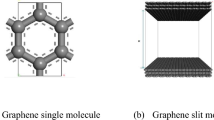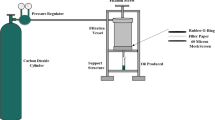Abstract
The phase behavior of fluid is essential for predicting ultimate oil recovery and determining optimal production parameters. The pore size in shale porous media is nanopore, which causes different phase behaviors of fluid in unconventional reservoirs. Nanopores in shale media can be regard as semipermeable membrane to filter heavy components (sieving effect) in shale oil, which leads to the different distributions of fluid components and different phase behaviors. In addition, the phase behavior of fluid in nanopores can be significantly altered by large capillary pressure. In this paper, the phase behavior of fluid in shale reservoirs is investigated by a new two-phase flash algorithm considering sieving effect and capillary pressure. Firstly, membrane efficiency and capillary pressure are introduced to establish a thermodynamic equilibrium model that is solved by Rachford–Rice flash calculation and Newton–Raphson method. The capillary pressures in different pore sizes are calculated by the Young–Laplace equation. Then, the influences of sieving effect and capillary pressure on phase behavior are analyzed. The results indicate that capillary pressure can suppress the bubble point pressure of fluid in nanopores. The distributions of fluid components are different in various parts of shale media. In the unfiltered part, density and viscosity of fluid are higher. Finally, it is found that the membrane efficiency can be improved by CO2 injection. The minimum miscibility pressure for shale oil–CO2 system is also studied. The developed model provides a better understanding of the phase behavior of fluid in shale oil reservoirs.









Similar content being viewed by others
Notes
1 psi = 6.89476 kPa.
References
Alfi, M., Nasrabadi, H., & Banerjee, D. (2016). Experimental investigation of confinement effect on phase behavior of hexane, heptane and octane using lab-on-a-chip technology. Fluid Phase Equilibria, 423, 25–33.
Alharthy, N. S., Teklu, T., Nguyen, T., et al. (2016). Nanopore Compositional Modeling in Unconventional Shale Reservoirs. SPE Reservoir Evaluation and Engineering, 19(03), 415–428.
Brenneman, M.C., & Smith, P.V. (1958). The chemical relationship between crude oils and their source rocks. Habitat of oil. American association of petroleum geologist, Tulsa, Oklahoma. pp. 818–849.
Brusilovsky, A. I. (1992). Mathematical simulation of phase behavior of natural multicomponent systems at high pressures with an equation of state. SPE Reservoir Evaluation and Engineering, 7, 117–122.
Christiansen, R. L., & Haines, H. K. (1987). Rapid measurement of minimum miscibility pressure with the rising-bubble apparatus. SPE Reservoir Evaluation and Engineering, 2(4), 523–527.
CMG. (2017). WinProp User’s Guide. Computer Modeling Group Ltd.
Daniel, S. R., Kishore, M., & Matthew, B. (2015). Reservoir simulation and optimization of Huff-and-Puff operations in the Bakken Shale. Fuel, 147, 82–94.
Geren, F., Firincioglu, T., Karacaer, C., et al. (2014). Modeling flow in nanoporous membrane reservoirs and interpretation of coupled fluxes. In: SPE Annual Technical Conference and Exhibition, Amsterdam, Netherlands, 27–29 October.
Gherabati, S. A., Browning, J., Frank, M., et al. (2016). The impact of pressure and fluid property variation on well performance of liquid-rich Eagle Ford shale. Journal of Natural Gas Science and Engineering, 33, 1056–1068.
Huseynova, J., & Ozkan, E. (2017). Hindered transport in nanoporous unconventional reservoirs and its implications on IOR and stimulation. In: SPE Annual Technical Conference and Exhibition, San Antonio, Texas, USA, 9–11 October.
Jia, B., Tsau, J. S., & Barati, R. (2019). A review of the current progress of CO2 injection EOR and carbon storage in shale oil reservoirs. Fuel, 236, 404–427.
Jin, Z., & Firoozabadi, A. (2016). Thermodynamic modeling of phase behavior in shale media. SPE Journal, 21(01), 190–207.
Kamalvand, M., Keshavarzi, T., & Mansoori, G. A. (2008). Behavior of the confined hardsphere fluid within nanoslits: a fundamental-measure density-functional theory study. International Journal of Nanoscience, 07, 245–253.
Li, L., Su, Y., Hao, Y., et al. (2019). A comparative study of CO2 and N2 huff-n-puff EOR performance in shale oil production. Journal of Petroleum Science and Engineering, 181, 106174.
Lohrenz, J., Bray, B. G., & Clark, C. R. (1964). Calculating viscosities of reservoir fluids from their compositions. Journal of Petroleum Technology, 16(10), 1171–1176.
Luo, S., Lutkenhaus, J. L., & Nasrabadi, H. (2018). Use of differential scanning calorimetry to study phase behavior of hydrocarbon mixtures in nano-scale porous media. Journal of Petroleum Science and Engineering, 163, 731–738.
Neshat, S., Okuno, R., & Pope, G. A. (2018). A rigorous solution to the problem of phase behavior in unconventional formations with high capillary pressure. SPE Journal, 23(04), 1438–1451.
Nojabaei, B., Johns, R. T., & Chu, L. (2013). Effect of capillary pressure on phase behavior in tight rocks and shales. Spe Reservoir Evaluation and Engineering, 16(03), 281–289.
Rachford, H. H., & Rice, J. D. (1952). Procedure for use of electronic digital computers in calculating flash vaporization hydrocarbon equilibrium. Journal of Petroleum Technology, 4(10), 327–328.
Rao, D. N., & Lee, J. I. (2002). Application of the new vanishing interfacial tension technique to evaluate miscibility conditions for the Terra Nova offshore project. Journal of Petroleum Science and Engineering, 35(3–4), 247–262.
Ren, L., Su, Y., Zhan, S., et al. (2019). Fully coupled fluid-solid numerical simulation of stimulated reservoir volume (SRV)-fractured horizontal well with multi-porosity media in tight oil reservoirs. Journal of Petroleum Science and Engineering, 174, 757–775.
Song, C., & Yang, D. (2017). Experimental and numerical evaluation of CO2 huff-n-puff processes in Bakken formation. Fuel, 190, 145–162.
Sun, H., & Li, H. (2019). A new three-phase flash algorithm considering capillary pressure in a confined space. Chemical Engineering Science, 193, 346–363.
Teklu, T., Alharthy, N. S., & Kazemi, H. (2014). Phase behavior and minimum miscibility pressure in nanopores. Spe Reservoir Evaluation and Engineering, 17(03), 396–403.
Travalloni, L., Castier, M., & Tavares, F. W. (2010). Thermodynamic modeling of confined fluids using an extension of the generalized van der Waals theory. Chemical Engineering Science, 65, 3088–3099.
Wachtmeister, H., Lund, L., Aleklett, K., & Höök, M. (2017). Production decline curves of tight oil wells in eagle ford shale. Natural Resources Research, 26, 365–377.
Wan, T., & Mu, Z. (2018). The use of numerical simulation to investigate the enhanced Eagle Ford shale gas condensate well recovery using cyclic CO2 injection method with nano-pore effect. Fuel, 233, 123–132.
Wang, L., Yin, X., Neeves, K., et al. (2016). Effect of pore-size distribution on phase transition of hydrocarbon mixtures in nanoporous media. SPE Journal, 21(06), 1981–1995.
Wilson, GM. (1968). A Modified Redlich-Kwong Equation of State Applicable to General Physical Data Calculations. In 65th AIChE National Meeting.
Wu, Q. (2014). Investigation of fluids flow behavior in nano-scale channels by using optic imaging system. Missouri University of Science and Technology.
Wu, Y., Patel, H., & Salehi, S. (2021). Parametric study of mechanical stresses within cement sheath in geothermal wells. Geothermics, 90, 102000.
Yelling, W. F., & Metcalfe, R. S. (1980). Determination and prediction of CO2 minimum miscibility pressures. Journal of Petroleum Technology, 32(1), 160–168.
Yu, W., Lashgari, H. R., Wu, K., et al. (2015). CO2 injection for enhanced oil recovery in Bakken tight oil reservoirs. Fuel, 159, 354–363.
Zhang, K., Jia, N., Li, S., et al. (2018). Thermodynamic phase behavior and miscibility of confined fluids in nanopores. Chemical Engineering Journal, 351, 1115–1128.
Zhang, Y., Lashgari, H. R., Di, Y., et al. (2017a). Capillary pressure effect on phase behavior of CO2/hydrocarbons in unconventional reservoirs. Fuel, 197, 575–582.
Zhang, Y., Yu, W., Sepehrnoori, K., et al. (2017b). Investigation of nanopore confinement on fluid flow in tight reservoirs. Journal of Petroleum Science and Engineering, 150, 265–271.
Zhu, Z., Fang, C., Qiao, R., et al. (2019). Experimental and molecular insights on sieving of hydrocarbon mixtures in niobrara shale. In: Unconventional Resources Technology Conference, Denver, Colorado, USA, 22–24 July.
Zhu, Z., Yin, X., & Ozkan, E. (2015). Theoretical investigation of the effect of membrane properties of nanoporous reservoirs on the phase behavior of confined light oil. In SPE Annual technical conference and exhibition, Houston, Texas, USA, 28–30 September.
Zuloaga, P., Yu, W., & Mao, J. (2017). Performance evaluation of CO2 Huff-n-Puff and continuous CO2 injection in tight oil reservoirs. Energy, 134, 181–192.
Acknowledgements
The research was supported by the Fundamental Research Funds for National Science and Technology Major Projects (2016ZX05011-002 and 2017ZX05009-005). The authors would like to thank the editors and anonymous referees for their valuable comments and suggestions.
Author information
Authors and Affiliations
Corresponding author
Appendices
Appendix A: Initial Equilibrium State
According to known conditions including the pressure (PII) and mole fraction of components (zIIi) in the filtered part, pressure in the unfiltered part (PI) and system temperature (T), the calculation process is given at initial equilibrium state to obtain mole fraction of components in the unfiltered part (zIi) and membrane efficiency (ωf). Based on equality of fugacity of light components and material balance in two parts, N equations can be written as follows:
where z is mole fraction of component, N is number of components, f is fugacity of component, and I and II denote unfiltered part and filtered part, respectively.
Equation (26) can be rewritten as:
In order to solve Eq. (27), Newton–Raphson method is used and the formation is obtained as follows:
where \(Ja\left( {i,j} \right) = \frac{{\partial F_{i} }}{{\partial z_{I}^{j} }}\), \({\text{for}}_{{}}^{{}} i = 1,2,...N - 1;_{{}}^{{}} {\text{for}}_{{}}^{{}} j = 1,2,...N - 1\)
Appendix B: Equilibrium State During Pressure Depletion
According to known conditions including the pressure in the filtered part (PII), membrane efficiency (ωf), the sum of mole of each component in both parts (ni), volume of the unfiltered part (VI) and system temperature (T), the calculation process is given during pressure depletion to obtain the mole of components in both parts (nIi, nIIi), the pressure in the filtered part (PI). Based on equality of fugacity of light components and material balance in two parts, membrane efficiency and volume conservation, 2 N + 1 equations can be written as follows:
The above equations can be simplified as:
In order to solve Eq. (34), Newton–Raphson method is used and the formation is obtained as follows:
where
Rights and permissions
About this article
Cite this article
Tian, Y., Ju, B., Wang, X. et al. Study on Phase Behavior of CO2/Hydrocarbons in Shale Reservoirs Considering Sieving Effect and Capillary Pressure. Nat Resour Res 30, 3533–3549 (2021). https://doi.org/10.1007/s11053-021-09886-6
Received:
Accepted:
Published:
Issue Date:
DOI: https://doi.org/10.1007/s11053-021-09886-6




